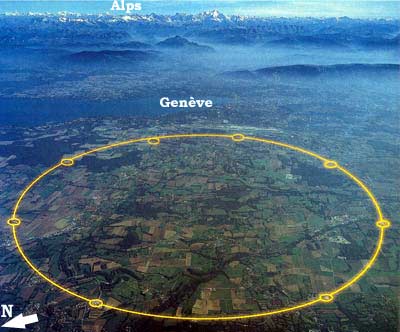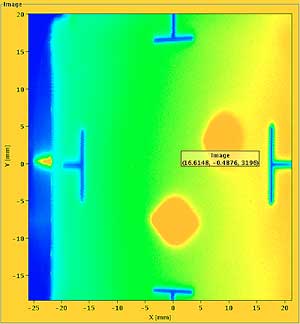

| About virtual QuarkNet |
What is QuarkNet |
to official QuarkNet site |
QuarkNet resources |
vQuarkNet wiki (collaboration center) |
Currently the premier physics laboratory, of many around the world, is the Large Hadron Collider. This, the world's largest particle accelerator, is located at the European Organization for Nuclear Research (CERN) straddling the border between France and Switzerland near Geneva. Bunches of protons (or sometimes heavy atomic nuclei) travel in opposite directions inside a pair of arm sized vacuum tubes bent along an 8+ km diameter circular path, colliding a locations where detectors have been constructed to study what new particles are formed from the high energy. The actual tubes, with super-conducting bending magnets, and accelerating Radio Frequency klystrons with their Niobium cavities, are located in a tunnel about 100 meters underground below the yellow circle superimposed on the photograph above. The giant Atlas detector is located at 2 o'clock in this image and the even more massive Compact Muon Solenoid detector is opposite in about the 9 o'clock position. (click on photo for more)
Wednesday, 10 September 2008 was the special day for particle physics: the startup of the Large Hadron Collider (LHC) at CERN. For the first time, protons circulated around the entire 27 km LHC ring.
During commissioning (without beam) of the final LHC sector (sector 34) at higher current for operation at 5 TeV, a large liquid Helium coolant leak occurred at mid-day Friday 19 September 2008. The most likely cause of the problem was a deficient electrical connection between two magnets which melted at high current leading to an avalanche of mechanical failures. There was no risk to people since everyone remains above the underground tunnel when operating. But that sector of the super cold, super conducting apparatus had to be warmed for repairs. Followed months to diagnose all shortcomings, re-engineer the components to prevent reoccurrence, rebuild that section of the accelerator, and install upgrades on the rest.
A Winter shutdown is traditionally scheduled from early December until April. While the LHC does use superconducting magnets and accelerators to maximize operation with a minimum of electrical power, it still uses significant amounts of power. In Switzerland where many residents and business use electric heat, electricity is priced higher during the Winter. So accelerators are seldom run in the Winter; experiments are conducted when it is most economical to do so.
A variety of planned upgrades to the LHC and the experiments were planned for the Winter 2008-9 break and additional fail-safe updates were done during the down time. The large particle detectors continued observing cosmic ray events as they had been doing. This provided an early way to tune the detectors. Occasionally cosmic rays collide with the Earth's atmosphere at energies far greater that the LHC will ever provide so this also provides an avenue of ongoing research.
The world's largest manmade particle accelerator was restarted at half power in November 2009 The machine began running at roughly half of its design energy, far less than some physicists would like, and eventually ramp up to higher energies in 2010.
We saw something cool today: the LHC is again circulating beam and we saw splash events in CMS pretty much real time. Splash events are where the beam hits a collimator and splashes particles all over the detector. The beam is running in one direction only at 450 GeV - the same energy it had on Sept 10 last year.
by anonymous on 7 Nov 2009 The first week in December saw the beams declared stable. The first routine
collisions were reported by the end of the second week of December 2009. The 2009 run ended 16 December. CMS cooling system leaks were repaired and other improvements made over the Winter. It was decided to next attempt a long run at 7 TeV (3.5 TeV per beam) lasting perhaps nearly two years with only brief technical shut downs. The first splash events were recorded late February. The first time stable squeezed beam at 3.5 TeV including an extra colliding bunch occurred in late April. This resulted in a factor 10 increase in the instantaneous luminosity.


| Learner Resources | Teacher Resources | virtual QuarkNet group |
| CMS home page for Compact Muon Solenoid detector | MasterClass lesson package learning to identify particles |
virtual QuarkNet Wiki collaboration center for physics teachers |
| About CMS introductory Powerpoint by Dan Green | ||
| CMS & Remote Operations introductory Powerpoint by Alan Stone | ||
| CMS FNAL Remote Operations access to current info! | ||
| CMS Times weekly news | ||
| CMS Physics | ||
| CMS e-Lab | ||
| CERN courier monthly news | ||
| ATLAS News | ||
| ATLAS Physics |
Investigations at CERN following a large Helium leak into sector 3-4 of the Large Hadron Collider (LHC) tunnel have confirmed that cause of the incident was a faulty electrical connection between two of the accelerator's magnets. This resulted in mechanical damage and release of Helium from the magnet cold masses into the tunnel. Sufficient spare components are in hand to restart in 2009. Measures to prevent a similar incident in the future are being put in place.

The curved sections of the LHC, extending over most of the length of each 3.3 km long sector, are composed of a repeating layout, the elementary cell of which (107 m long) is composed of a horizontally focusing quadrupole magnet, three beam curving dipole magnets (cross section at right→), a vertically focusing quadrupole magnet and another three dipole magnets. The magnets are electrically powered with the current passing in series throughout the sector. The magnets, equipped with their Helium vessel and end covers, constitute the cold masses, which, in normal operation, contain superfluid Helium at 1.9 K and 0.13 MPa, and are thermally insulated from the vacuum enclosure. The neighbouring cold masses are electrically and hydraulically interconnected. The weight of the cold mass is transmitted to the vacuum enclosure via cold support posts and is further transmitted to the tunnel floor by adjustable support jacks, anchored in the concrete. The cryogenic system, fed from the cryogenic distribution line through a jumper connection every 107 m at the location of a quadrupole. Two subsequent sections constitute a vacuum subsector sharing a common insulation vacuum; the insulation vacuum enclosures of neighbouring subsectors are separated by vacuum barriers. The two beam pipes constitute two other separate vacuum systems.
derived from information provided by James.Gillies, 16 October, forwarded by Ken Cecire


 |
This project has been supported in part through QuarkNet at FermiLab by the National Science Foundation and the Office of High Energy Physics, Office of Science, U.S. Department of Energy. However the choice of content, opinions expressed and any omissions or other errors are those of D Trapp and not the responsibility of QuarkNet, NSF or DoE. |